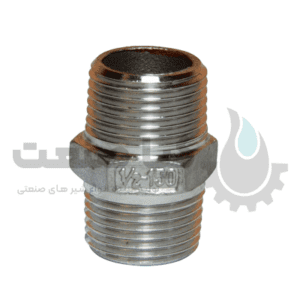nipple fitting
Showing the single result
Nipple fitting
Nipple fitting
Nipple fitting is a type of pipe connection that is used to connect two pipes or fittings to each other.
It is a short piece of pipe with male threads on both ends that allow for connection and disconnection.
They come in different lengths and sizes for use in different piping systems.
Types of brain connections
There are three main types of brain connections:
- Closed brain: The tip is a short piece of pipe with male connectors at both ends. It is used to firmly connect two pipes or female threaded connections to each other.
- Long brain: Similar to closed brain but with more length. It is used when additional space is needed between two pipes or connected fittings.
- Hexagonal brain: It has a male connection at its end, which is smooth in the middle. The flat side of this hexagonal nut allows for easy tightening or loosening with a wrench. It is usually used in systems that require a safe and secure connection.
Type of brain connections
- Carbon Steel: Carbon steel hubs are very strong and durable, making them suitable for various industrial applications. Carbon steel brain connections are resistant to corrosion and can withstand high pressure and temperature conditions.
- Stainless Steel: Nut fittings made of stainless steel have excellent corrosion resistance and are ideal for applications where the fittings may come into contact with moisture, chemicals or other corrosive substances. are al.
- Brass: Brass nut fittings are often used in plumbing and water system applications. Brass is a durable and versatile material that has good resistance to corrosion and is easy to work with.
- pvc: PVC pipe fittings are commonly used in irrigation, drainage and other water-based applications. PVC is a lightweight, corrosion-resistant material that is easy to install and offers good chemical resistance.
- Copper: Copper fittings are often used in piping systems. Copper is a durable and corrosion-resistant material that is suitable for hot and cold water applications.
- Galvanized steel: Galvanized steel brain connections have a zinc protective coating that has high corrosion resistance. Galvanized studs are often used in outdoor or industrial applications where exposure to moisture or harsh environments is a concern.
- Cast iron: Cast iron nut fittings are strong and durable and suitable for heavy duty applications. Cast iron brain connections are usually used in drainage and sewage systems.
- Aluminum: Aluminum nut fittings are lightweight and corrosion resistant, making them suitable for applications where weight is a concern or where corrosion resistance is required.
>
These are just a few examples of the different materials used in making brain connectors. Better choice of brain type should consider factors such as application, environment and performance characteristics you want.

